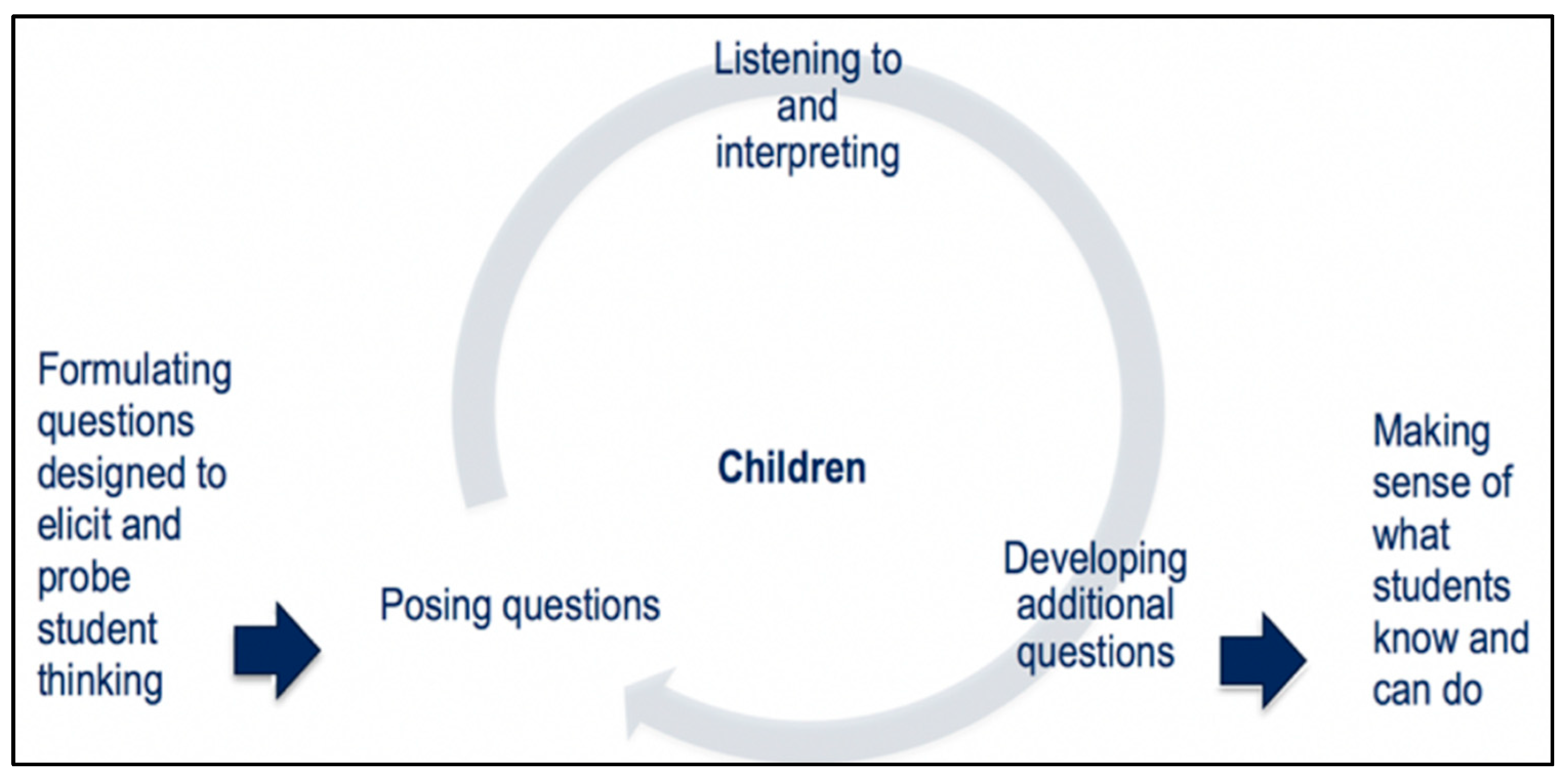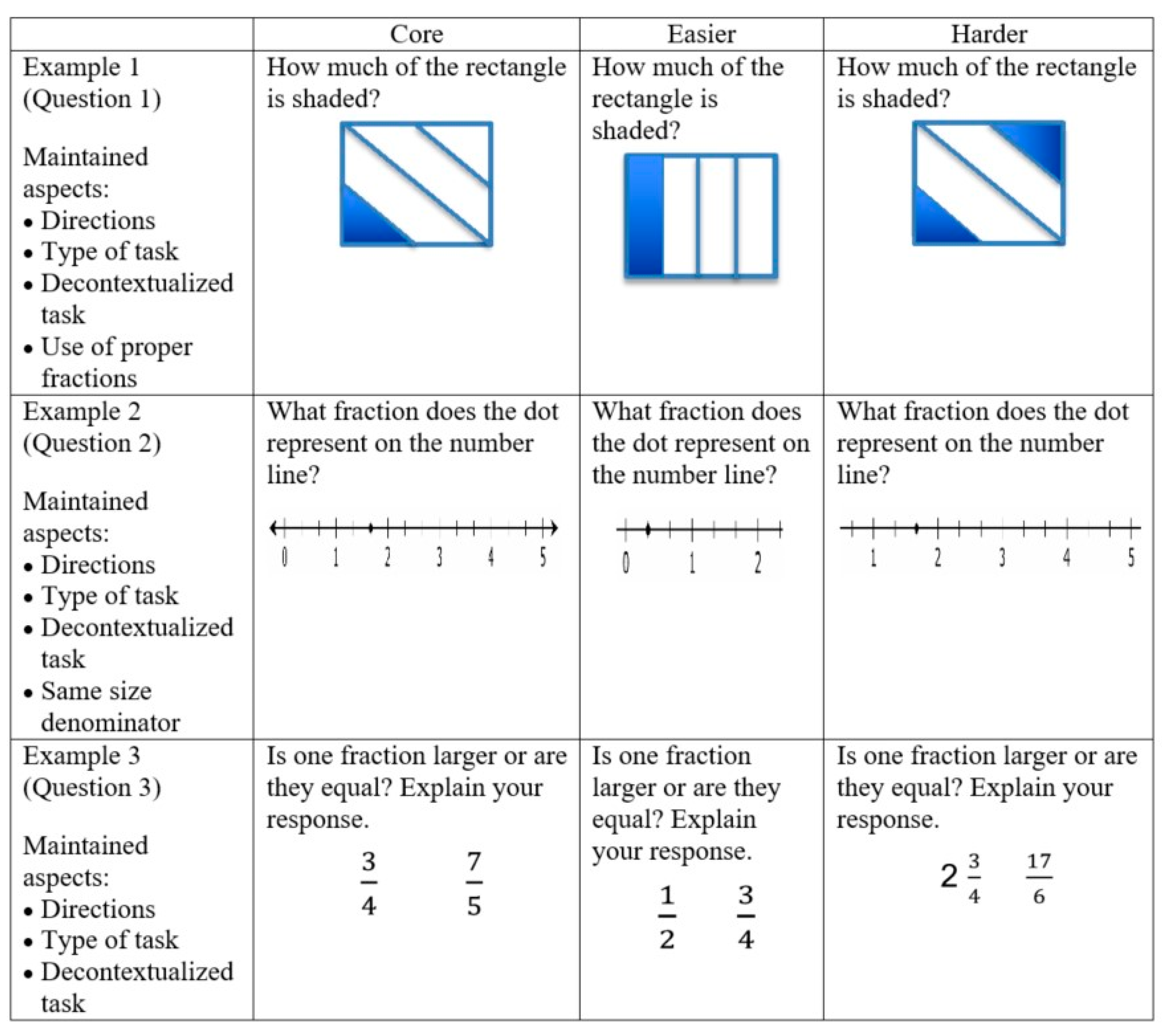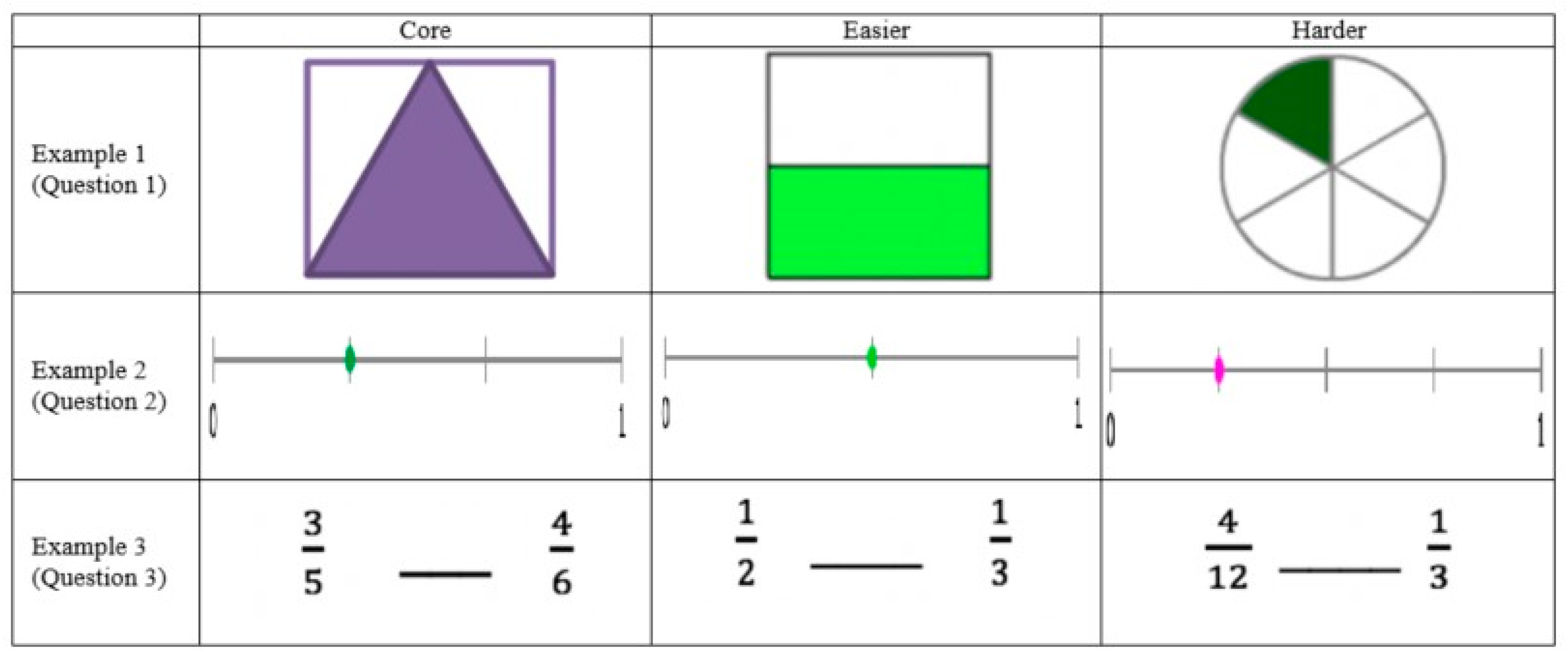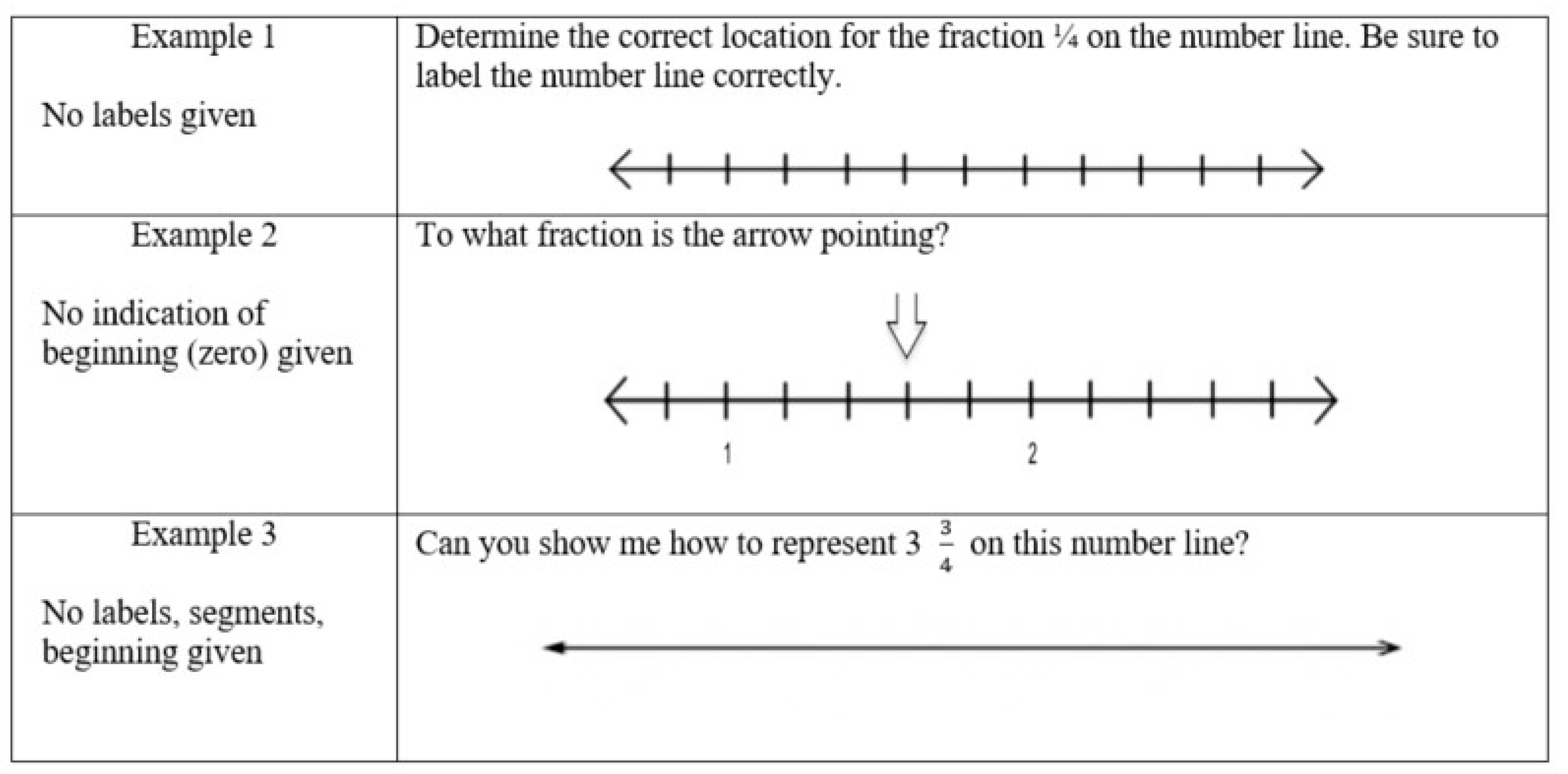Building Preservice Teachers’ Diagnostic Competence: An Exploratory Study in the Domain of Fractions
Abstract
:1. Introduction
2. Theoretical Framework
2.1. Teaching Fractions
2.2. Teachers’ Diagnostic Competence
2.3. Teachers’ Problem Posing—Eliciting and Interpreting
2.4. Teachers’ Ability to Develop Mathematics Assessment Items
3. Methods
3.1. Participants and Context
3.2. Tasks and Data Collection
3.3. Data Analysis
4. Findings
4.1. PSTs’ Anticipation of Student Difficulties
4.2. Unaltered Aspect of Assessment
4.3. Modification Strategies
5. Discussion
5.1. Awareness of Varied Levels of Sophistication
5.2. Consideration of Mathematical Aspects and Pedagogical Aspects
5.3. Calibration of Intended Difficulty
5.4. Limitations of the Study
6. Conclusions
Author Contributions
Funding
Institutional Review Board Statement
Informed Consent Statement
Data Availability Statement
Conflicts of Interest
Appendix A
- (1)
- Question Set #1
- Target standard: understand a fraction 1/b as the quantity formed by 1 part when a whole is partitioned into b equal parts; understand a fraction a/b as the quantity formed by a pieces of 1/b.
- Required representation to include: Area model
- (2)
- Question Set #2
- Target standard: understand a fraction as a number on the number line; represent fractions on a number line diagram.
- Required representation to include: a number line model
- (3)
- Question Set #3
- Target standard: explain the equivalence of fractions in special cases and compare fractions by reasoning about their size.
- Representation to include: use any representation of your choice.
- (1)
- Present a core question.
- (2)
- Anticipated confusion: list particular aspects of math content that may be potentially confusing or misconstrued by the student.
- (3)
- Follow-up questions: refer to the mathematical goals and possible student confusion. Thinking of various possible scenarios, list follow-up questions/prompts that will either confirm students’ understanding or reveal students’ misconceptions.
- (4)
- Differentiated questions: prepare at least one less challenging question (i.e., easier than the core question) and one advanced question (i.e., harder than the core question) for differentiation.
- (5)
- Answer key: provide the answer key for core questions and follow-up questions along with your explanations (your explanations should be appropriate for the target grade level). A completed key should also show your note regarding correct concept applications and appropriate pedagogies.
| Target Standard: |
| Core question: |
| Anticipated confusion: |
| Follow-up questions: |
Differentiated questions
|
| Answer key: |
References
- Feiman-Nemser, S. From preparation to practice: Designing a continuum to strengthen and sustain teaching. Teach. Coll. Rec. 2001, 103, 1013–1055. [Google Scholar] [CrossRef]
- Cooney, T.J. Teachers’ decision making. In Mathematics, Teachers and Children; Pimm, D., Ed.; Hodder & Stoughton: London, UK, 1988; pp. 273–286. [Google Scholar]
- Krolak-Schwerdt, S.; Glock, S.; Böhmer, M. (Eds.) Teachers’ Professional Development: Assessment, Training, and Learning; Sense Publishers: Rotterdam, The Netherlands, 2014. [Google Scholar]
- van de Pol, J.; Volman, M.; Oort, F.; Beishuizen, J. The effects of scaffolding in the classroom: Support contingency and student independent working time in relation to student achievement, task effort and appreciation of support. Instr. Sci. 2015, 43, 615–641. [Google Scholar] [CrossRef] [Green Version]
- Choy, B.H.; Thomas, M.O.J.; Yoon, C. The FOCUS framework: Characterising productive noticing during lesson planning, delivery and review. In Teacher Noticing: Bridging and Broadening Perspectives, Contexts, and Frameworks; Schack, E.O., Fisher, M.H., Wilhelm, J.A., Eds.; Springer: Cham, Switzerland, 2017; pp. 445–466. [Google Scholar]
- Südkamp, A.; Kaiser, J.; Möller, J. Teachers’ judgments of students’ academic achievement. In Teachers’ Professional Development: Assessment, Training, and Learning; Krolak-Schwerdt, S., Glock, S., Böhmer, M., Eds.; Sense Publishers: Rotterdam, NL, USA, 2014; pp. 5–25. [Google Scholar]
- Vogt, F.; Rogalla, M. Developing adaptive teaching competency through coaching. Teach. Teach. Educ. 2009, 25, 1051–1060. [Google Scholar] [CrossRef] [Green Version]
- Yang, Y.; Ricks, T.E. Chinese lesson study: Developing classroom instruction through collaborations in school-based teaching research group activities. In How Chinese Teach Mathematics and Improve Teaching; Li, Y., Huang, R., Eds.; Routledge: New York, NY, USA, 2013; pp. 51–65. [Google Scholar]
- Prediger, S. How to develop mathematics-for-teaching and for understanding: The case of meanings of the equal sign. J. Math. Teach. Educ. 2010, 13, 73–93. [Google Scholar] [CrossRef]
- Edelenbos, P.; Kubanek-German, A. Teacher assessment: The concept of diagnostic competence. Lang. Test. 2004, 21, 259–283. [Google Scholar] [CrossRef]
- Common Core State Standards Initiatives. Common Core State Standards for Mathematics; National Governors Association Center for Best Practices and the Council of Chief State School Officers: Washington, DC, USA, 2010; Available online: http://www.corestandards.org/wp-content/uploads/Math_Standards1.pdf (accessed on 10 June 2020).
- Phelps-Gregory, C.; Spitzer, S. Developing prospective teachers’ ability to diagnose evidence of student thinking: Replicating a classroom intervention. In Diagnostic Competence of Mathematics Teachers. Mathematics Teacher Education; Leuders, T., Philipp, K., Leuders, J., Eds.; Springer International Publishing: Cham, Switzerland, 2018; Volume 11, pp. 223–240. [Google Scholar]
- Reinhold, S. Revealing and promoting pre-service teachers’ diagnostic strategies in mathematical interviews with first-graders. In Diagnostic Competence of Mathematics Teachers. Mathematics Teacher Education; Leuders, T., Philipp, K., Leuders, J., Eds.; Springer International Publishing: Cham, Switzerland, 2018; Volume 11, pp. 129–148. [Google Scholar]
- Kılıç, Ç. Pre-service primary teachers’ free problem-posing performances in the context of fractions: An example from Turkey. Asia-Pac. Educ. Res. 2013, 22, 677–686. [Google Scholar] [CrossRef]
- Lee, M.Y.; Lee, J. Pre-service teachers’ perceptions of the use of representations and suggestions for students’ incorrect use. Eurasia J. Math. Sci. Technol. Educ. 2019, 15, 1–21. [Google Scholar] [CrossRef]
- Confrey, J. Splitting, similarity, and rate of change: A new approach to multiplication and exponential functions. In The Development of Multiplicative Reasoning in Learning of Mathematics; Harel, G., Confrey, J., Eds.; State University of New York Press: New York, NY, USA, 1994; pp. 291–330. [Google Scholar]
- Lamon, S.J. Rational numbers and proportional reasoning: Toward a theoretical framework for research. In Second Handbook of Research on Mathematics Teaching and Learning; Lester, F.K., Jr., Ed.; Information Age Publishing: Charlotte, NC, USA, 2007; Volume 1, pp. 629–667. [Google Scholar]
- Steffe, L.P.; Olive, J. Children’s Fractional Knowledge; Springer: New York, NY, USA, 2010. [Google Scholar]
- Lamon, S.J. The development of unitizing: Its role in children’s partitioning strategies. J. Res. Math. Educ. 1996, 27, 170–193. [Google Scholar] [CrossRef]
- Steffe, L.P. Fractional commensurate, composition, and adding schemes: Learning trajectories of Jason and Laura: Grade 5. J. Math. Behav. 2003, 22, 237–295. [Google Scholar] [CrossRef]
- Lee, M.Y. Pre-service teachers’ flexibility with referent units in solving a fraction division problem. Educ. Stud. Math. 2017, 96, 327–348. [Google Scholar] [CrossRef]
- Olanoff, D.; Lo, J.; Tobias, J. Mathematical content knowledge for teaching elementary mathematics: A focus on fractions. Math. Enthus. 2014, 11, 267–310. [Google Scholar]
- Stoddart, T.; Connell, M.; Stofflett, R.; Peck, D. Reconstructing elementary teacher candidates’ understanding of mathematics and science content. Teach. Teach. Educ. 1993, 9, 229–241. [Google Scholar] [CrossRef]
- Rosli, R.; Han, S.; Capraro, R.; Capraro, M. Exploring preservice teachers’ computational and representational knowledge of content and teaching fractions. Res. Math. Educ. 2013, 17, 221–241. [Google Scholar] [CrossRef] [Green Version]
- van de Walle, J.; Karp, K.S.; Bay-Williams, J.M. Elementary and Middle School Mathematics: Teaching Developmentally, 8th ed.; Pearson: Upper Saddle River, NJ, USA, 2013. [Google Scholar]
- Cramer, K.; Whitney, S. Learning rational number concepts and skills in elementary classrooms. In Teaching and Learning Mathematics: Translating Research to the Elementary Classroom; Lambdin, D.V., Lester, F.K., Eds.; NCTM: Reston, VA, USA, 2010; pp. 15–22. [Google Scholar]
- Chong, Y.O. Teaching proportional reasoning in elementary school mathematics. J. Educ. Res. Math. 2015, 25, 21–58. [Google Scholar]
- Empson, S.B.; Junk, D.; Dominguez, H.; Turner, E. Fractions as the coordination of multiplicatively related quantities: A cross-sectional study of children’s thinking. Educ. Stud. Math. 2006, 63, 1–28. [Google Scholar] [CrossRef]
- Guo, W.; Wei, J. Teacher Feedback and Students’ Self-regulated Learning in Mathematics: A Study of Chinese Secondary Students. Asia-Pac. Educ. Res. 2019, 28, 265–275. [Google Scholar] [CrossRef]
- Black, P.; Wiliam, D. Assessment and Classroom Learning. Assess. Educ. 1998, 5, 7–74. [Google Scholar] [CrossRef]
- Nichols, P.D.; Meyers, J.L.; Burling, K.S. A framework for evaluating and planning assessments intended to improve student achievement. Educ. Meas. Issues Pract. 2009, 28, 14–23. [Google Scholar] [CrossRef]
- Tomlinson, C.A. How to Differentiate Instruction in Mixed-Ability Classrooms, 2nd ed.; Association for Supervision & Curriculum Development: Alexandria, VA, USA, 2001. [Google Scholar]
- Tomlinson, C.A.; Eidson, C.C. Differentiation in Practice: A Resource Guide for Differentiating Curriculum, Grades 5–9; Association for Supervision and Curriculum Development: Alexandria, VA, USA, 2003. [Google Scholar]
- Kaplan, H.A.; Argün, Z. Teachers’ diagnostic competences and levels pertaining to students’ mathematical thinking: The case of three math teachers in Turkey. Educ. Sci. Theory Pract. 2017, 17, 2143–2174. [Google Scholar]
- Yang, Y.; Ricks, T.E. How crucial incidents analysis support Chinese lesson study. Int. J. Lesson Learn. Stud. 2012, 1, 41–48. [Google Scholar] [CrossRef]
- Lee, M.Y.; Choy, B.H. Mathematical teacher noticing: The key to learning from Lesson Study. In Teacher Noticing: Bridging and Broadening Perspectives, Contexts, and Frameworks; Schack, E.O., Fisher, M., Wilhelm, F., Eds.; Springer: New York, NY, USA, 2017; pp. 121–140. [Google Scholar]
- Jang, E.E.; Wagner, M. Diagnostic feedback in language classroom. In Companion to Language Assessment; Kunnan, A., Ed.; Wiley-Blackwell: Hoboken, NJ, USA, 2013; Volume II, pp. 693–711. [Google Scholar]
- Singer, F.M.; Ellerton, N.F.; Cai, J. (Eds.) Mathematical Problem Posing: From Research to Effective Practice; Springer: New York, NY, USA, 2015. [Google Scholar]
- Cai, J.; Chen, T.; Li, X.; Xu, R.; Zhang, S.; Hu, Y.; Zhang, L.; Song, N. Exploring the impact of a problem-posing workshop on elementary school mathematics teachers’ conceptions on problem posing and lesson design. Int. J. Educ. Res. 2020, 102, 101404. [Google Scholar] [CrossRef]
- Crespo, S. Learning to pose mathematical problems: Exploring changes in preservice teachers’ practices. Educ. Stud. Math. 2003, 52, 243–270. [Google Scholar] [CrossRef]
- Crespo, S.; Sinclair, N. What makes a problem mathematically interesting? Inviting prospective teachers to pose better problems. J. Math. Teach. Educ. 2008, 11, 395–415. [Google Scholar] [CrossRef]
- Olson, J.C.; Knott, L. When a problem is more than a teacher’s question. Educ. Stud. Math. 2013, 83, 27–36. [Google Scholar] [CrossRef]
- TeachingWorks (n.d.-a). High-Leverage Practices. Available online: http://www.teachingworks.org/work-of-teaching/high-leverage-practices (accessed on 5 December 2019).
- Ketterlin-Geller, L.R.; Shivraj, P.; Basaraba, D.; Yovanoff, P. Considerations for using mathematical learning progressions to design diagnostic assessments. Meas. Interdiscip. Res. Perspect. 2019, 17, 1–22. [Google Scholar] [CrossRef]
- TeachingWorks (n.d.-b). High-Leverage Content. Available online: http://www.teachingworks.org/work-of-teaching/high-leverage-content (accessed on 5 December 2019).
- Liljedahl, P.; Chernoff, E.; Zazkis, R. Interweaving mathematics and pedagogy in task design: A tale of one task. J. Math. Teach. Educ. 2007, 10, 239–249. [Google Scholar] [CrossRef]
- National Council of Teachers of Mathematics. Procedural Fluency in Mathematics: A position of the National Council of Teachers of Mathematics; NCTM: Reston, VA, USA, 2014. [Google Scholar]
- Vistro-Yu, C. Using innovation techniques to generate ‘new’ problems. In Mathematical Problem Solving: Yearbook 2009; Kaur, B., Yeap, B.H., Kapur, M., Eds.; Association of Mathematics Education and World Scientific: Singapore, 2009; pp. 185–207. [Google Scholar]
- Stickles, P. An Analysis of Secondary and Middle School Teacher’s Mathematical Problem Posing. Unpublished. Ph.D. Dissertation, Indiana University, Bloomington, IN, USA, 2006. [Google Scholar]
- National Governors Association Center for Best Practices & Council of Chief State School Officers. Common Core State Standards; National Governors Association Center for Best Practices & Council of Chief State School Officer: Washington, DC, USA, 2010; Available online: https://ccsso.org/resource-library/ada-compliant-math-standards (accessed on 10 June 2020).
- Ball, D.; Forzani, F. Building a common core for learning to teach: And connecting professional learning to practice. Am. Educ. 2011, 35, 17–21, 38–39. [Google Scholar]
- Lewis, G.; Perry, R. Lesson study to scale up research-based knowledge: A randomized, controlled trial of fractions learning. J. Res. Math. Educ. 2017, 48, 261–299. [Google Scholar] [CrossRef]
- Creswell, J.W. Research Design: Qualitative, Quantitative and Mixed Methods Approaches; Sage: Thousand Oaks, CA, USA, 2017. [Google Scholar]
- DeCuir-Gunby, J.T.; Marshall, P.L.; McCulloch, A.W. Developing and using a codebook for the analysis of interview data: An example from a professional development research project. Field Methods 2011, 23, 136–155. [Google Scholar] [CrossRef]
- Grbich, C. Qualitative Data Analysis: An Introduction, 2nd ed.; Sage: Thousand Oaks, CA, USA, 2013. [Google Scholar]
- Lithner, J. A research framework for creative reasoning. Educ. Stud. Math. 2008, 67, 255–276. [Google Scholar] [CrossRef]
- Stein, M.K.; Grover, B.W.; Henningsen, M. Building student capacity for mathematical thinking and reasoning: An analysis of mathematical tasks used in reform classrooms. Am. Educ. Res. J. 1996, 33, 455–488. [Google Scholar] [CrossRef]
- Shaughnessy, M.; Boerst, T.A. Uncovering the skills that preservice teachers bring to teacher education: The practice of eliciting a student’s thinking. J. Teach. Educ. 2018, 69, 40–55. [Google Scholar] [CrossRef] [Green Version]
- Lee, J.-E.; Son, J.-W. Two teacher educators’ approaches to developing preservice elementary teachers’ mathematics assessment literary: Intentions, outcomes, and new learning. Teach. Learn. Inquiry ISSOTL J. 2015, 3, 47–62. [Google Scholar]
- Stigler, J.W.; Gallimore, R.; Hiebert, J. Using video surveys to compare classrooms and teaching across cultures: Examples and lessons from the TIMSS video studies. Educ. Psychol. 2000, 35, 87–100. [Google Scholar] [CrossRef]
- Lee, D.H.L.; Hong, H.; Niemi, H.A. Contextualized account of holistic education in Finland and Singapore: Implications on Singapore educational context. Asia-Pac. Educ. Res. 2014, 23, 871–884. [Google Scholar] [CrossRef]






| Question Set | Relevant Standards | Required Representation |
|---|---|---|
| 1 | Understand a fraction 1/b as the quantity formed by 1 part when a whole is partitioned into b equal parts; understand a fraction a/b as the quantity formed by a pieces of 1/b. | Area model |
| 2 | Understand a fraction as a number on the number line; represent fractions on a number line diagram. | Number line |
| 3 | Explain the equivalence of fractions in special cases and compare fractions by reasoning about their size. | Not specified |
| Questions (Frequency: Percentage of PSTs Who Mentioned the Anticipated Difficulty) | |||
|---|---|---|---|
| Question 1 | Question 2 | Question 3 | |
| Understanding basic concepts related to fractions |
|
|
|
| Rules/Algorithms |
|
|
|
| Equivalent Fractions |
|
|
|
| Representation-related Issues |
|
| |
| Types of Fractions |
|
| |
| Benchmark Fractions |
|
| |
| Other |
|
| |
| Main Category | Subcategory | From Core to Easier | From Core to Harder | ||||
|---|---|---|---|---|---|---|---|
| Q#1 | Q#2 | Q#3 | Q#1 | Q#2 | Q#3 | ||
| Direction of the question | Exactly the same directions | 24 (42%) | 28 (49%) | 38 (67%) | 19 (33%) | 19 (33%) | 36 (63%) |
| Minor revisions with no substantial changes | 28 (49%) | 24 (42%) | 16 (28%) | 32 (56%) | 29 (51%) | 16 (28%) | |
| Type/format of the task | Multiple choices | 2 (4%) | 12 (21%) | 1 (2%) | 1 (2%) | 6 (11%) | 2 (4%) |
| Short answer questions | 35 (61%) | 29 (51%) | 39 (68%) | 28 (49%) | 32 (56%) | 37 (65%) | |
| Ask for explanations | 4 (8%) | 1 (2%) | 10 (18%) | 10 (18%) | 1 (2%) | 11 (19%) | |
| Type of fractions | Unit fraction | 27 (47%) | 10 (18%) | 29 (51%) | 15 (26%) | 5 (9%) | 10 (18%) |
| Proper (non-unit proper) | 18 (32%) | 14 (25%) | 37 (65%) | 23 (40%) | 14 (25%) | 37 (65%) | |
| Improper fraction | 0 (0%) | 2 (4%) | 0 (0%) | 2 (4%) | 7 (16%) | 3 (5%) | |
| Mixed numbers | 0 (0%) | 2 (4%) | 0 (0%) | 0 (0%) | 9 (16%) | 2 (4%) | |
| Size of fractions | Same fraction value | 13 (23%) | 8 (14%) | 4 (8%) | 8 (14%) | 8 (14%) | 2 (4%) |
| Same-sized denominator | 17 (30%) | 17 (30%) | 2 (4%) | 13 (23%) | 15 (26%) | 5 (9%) | |
| Context | Contextualized task | 5 (9%) | 1 (2%) | 5 (9%) | 7 (12%) | 0 (0%) | 3 (5%) |
| Decontextualized task | 46 (81%) | 52 (91%) | 49 (86%) | 47 (82%) | 49 (86%) | 51 (89%) | |
| None | None remains the same | 0 (0%) | 0 (0%) | 0 (0%) | 0 (0%) | 2 (4%) | 0 (0%) |
| Question | Main Category | Subcategory | From Core to Easier | From Core to Harder |
|---|---|---|---|---|
| Question 1 | Defining the whole | One geometric shape as a whole | 30 (52%) | 26 (46%) |
| Same shape as a whole | 18 (32%) | 13 (23%) | ||
| Arrangement of parts | Congruent parts (unit is evident) | 26 (46%) | 21(37%) | |
| Non-congruent parts | 3 (5%) | 16 (28%) | ||
| Parts are continuous | 8 (14%) | 4 (7%) | ||
| Parts are discrete | 8 (14%) | 10 (18%) | ||
| Question 2 | Number line representation | Same number line | 14 (25%) | 10 (18%) |
| All whole numbers are labeled | 44 (77%) | 32 (56%) | ||
| Number line starts from 0 | 37 (65%) | 24 (42%) | ||
| Question 3 | Representation | Symbolic only | 49 (86%) | 52 (91%) |
| Symbolic and pictorial | 4 (7%) | 1 (2%) | ||
| Denominators | Like denominators | 7 (12%) | 3 (5%) | |
| Unlike denominators | 34 (60%) | 47 (82%) |
| Main Category | Subcategory * | From Core to Easier | From Core to Harder | ||||
|---|---|---|---|---|---|---|---|
| Q#1 | Q#2 | Q#3 | Q#1 | Q#2 | Q#3 | ||
| Type/format of the task | Multiple choices | 1 (2%) | 3 (5%) | 0 (0%) | 1 (2%) | 0 (0%) | 0 (0%) |
| Short-answer questions | 11 (19%) | 9 (16%) | 3 (5%) | 11 (19%) | 11 (19%) | 3 (5%) | |
| Ask for explanations | 0 (0%) | 0 (0%) | 0 (0%) | 3 (5%) | 1 (2%) | 2 (4%) | |
| Type of fractions | Unit fraction | 12 (21%) | 21 (37%) | 12 (21%) | 6 (11%) | 2 (4%) | 0 (0%) |
| Proper (non-unit proper) | 4 (8%) | 6 (11%) | 4 (8%) | 10 (18%) | 2 (4%) | 6 (11%) | |
| Improper fraction | 0 (0%) | 0 (0%) | 1 (2%) | 0 (0%) | 9 (16%) | 7 (12%) | |
| Mixed numbers | 0 (0%) | 0 (0%) | 0 (0%) | 1 (2%) | 5 (9%) | 4 (8%) | |
| Size of fractions | Smaller denominators | 23 (40%) | 27 (47%) | 30 (53%) | 13 (23%) | 13 (23%) | 9 (16%) |
| Larger denominators | 10 (18%) | 4 (8%) | 16 (28%) | 23 (40%) | 22 (39%) | 32 (56%) | |
| Context | Contextualized task | 1 (2%) | 0 (0%) | 0 (0%) | 0 (0%) | 1 (2%) | 0 (0%) |
| Decontextualized task | 1 (2%) | 2 (4%) | 0 (0%) | 0 (0%) | 0 (0%) | 0 (0%) | |
| Representation | Incorporating pre-made (pre-cut) manipulatives | 0 (0%) | 0 (0%) | 1 (2%) | 1 (2%) | 0 (0%) | 0 (0%) |
| Openness | Allowing student choices (resulting in varied answers) | 1 (2%) | 1 (2%) | 0 (0%) | 4 (8%) | 7 (12%) | 2 (4%) |
| Question | Main Category | Subcategory * (Changes from Core) | From Core to Easier | From Core to Harder |
|---|---|---|---|---|
| Question 1 | Whole | Using different shapes as a whole | 18 (32%) | 23 (40%) |
| Arrangement of parts | Congruent parts (unit is evident) | 17 (30%) | 4 (7%) | |
| Non-congruent parts | 3 (5%) | 6 (11%) | ||
| Continuous parts | 9 (16%) | 1(2%) | ||
| Discrete parts | 1(2%) | 16 (28%) | ||
| Question 2 | Number line representation | All whole numbers are labeled | 3 (5%) | 0 (0%) |
| Some fractions are labeled | 7 (12%) | 3 (5%) | ||
| Nothing is labeled or segmented | 2 (4%) | 14 (25%) | ||
| All segments are presented | 2 (4%) | 0 (0%) | ||
| Number line starts from 0 | 10 (18%) | 0 (0%) | ||
| Number line does not start from 0 | 4 (7%) | 13 (23%) | ||
| Question 3 | Denominators | Like denominators | 8 (14%) | 3 (5%) |
| Unlike denominators (two denominators are coprime) | 17 (30%) | 32 (56%) |
| Core | Harder | |
|---|---|---|
| (a) | ||
| (b) | ||
| (c) | ||
| (d) | ||
| (e) |
Publisher’s Note: MDPI stays neutral with regard to jurisdictional claims in published maps and institutional affiliations. |
© 2021 by the authors. Licensee MDPI, Basel, Switzerland. This article is an open access article distributed under the terms and conditions of the Creative Commons Attribution (CC BY) license (https://creativecommons.org/licenses/by/4.0/).
Share and Cite
Lee, J.-E.; Pak, B.; Lim, W. Building Preservice Teachers’ Diagnostic Competence: An Exploratory Study in the Domain of Fractions. Mathematics 2021, 9, 1870. https://doi.org/10.3390/math9161870
Lee J-E, Pak B, Lim W. Building Preservice Teachers’ Diagnostic Competence: An Exploratory Study in the Domain of Fractions. Mathematics. 2021; 9(16):1870. https://doi.org/10.3390/math9161870
Chicago/Turabian StyleLee, Ji-Eun, Byungeun Pak, and Woong Lim. 2021. "Building Preservice Teachers’ Diagnostic Competence: An Exploratory Study in the Domain of Fractions" Mathematics 9, no. 16: 1870. https://doi.org/10.3390/math9161870
APA StyleLee, J.-E., Pak, B., & Lim, W. (2021). Building Preservice Teachers’ Diagnostic Competence: An Exploratory Study in the Domain of Fractions. Mathematics, 9(16), 1870. https://doi.org/10.3390/math9161870






